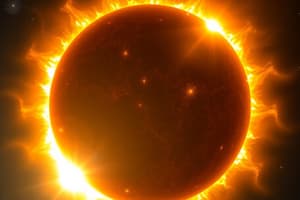Podcast
Questions and Answers
What is the Sun made of?
What is the Sun made of?
Plasma and about 75% Hydrogen and 25% Helium.
What causes the core to be extremely dense?
What causes the core to be extremely dense?
Gravity
What is nuclear fusion?
What is nuclear fusion?
The core's density causes 4 Hydrogen atoms to combine to form a single Helium atom and 2 neutrons.
What is the Sun classified as?
What is the Sun classified as?
How much of the Solar mass does the Sun make up?
How much of the Solar mass does the Sun make up?
How long does it take light to travel from the Sun to the Earth?
How long does it take light to travel from the Sun to the Earth?
What is the Core?
What is the Core?
What is the radiation zone?
What is the radiation zone?
What is the Convection Zone?
What is the Convection Zone?
What is the Photosphere?
What is the Photosphere?
What is the Chromosphere?
What is the Chromosphere?
What is the Corona?
What is the Corona?
What are Sunspots?
What are Sunspots?
What are Prominences?
What are Prominences?
What are Solar Flares?
What are Solar Flares?
What is Solar Wind?
What is Solar Wind?
What are the Sun's layers?
What are the Sun's layers?
What are the different sizes of stars (largest to smallest)?
What are the different sizes of stars (largest to smallest)?
What is a star's temperature relationship in relation to color?
What is a star's temperature relationship in relation to color?
What are the stages of a low-mass star's stellar evolution?
What are the stages of a low-mass star's stellar evolution?
What are the stages of a high-mass star's stellar evolution?
What are the stages of a high-mass star's stellar evolution?
What are the types of galaxies?
What are the types of galaxies?
Explain the evidence for the Big Bang Theory.
Explain the evidence for the Big Bang Theory.
Flashcards are hidden until you start studying
Study Notes
Composition and Structure of the Sun
- The Sun consists of plasma, primarily made up of 75% Hydrogen and 25% Helium.
- Gravity results in the extreme density of the core, where nuclear fusion occurs at approximately 15 million degrees Celsius.
Nuclear Fusion and Star Classification
- Nuclear fusion involves the combination of 4 Hydrogen atoms to create 1 Helium atom and 2 neutrons.
- The Sun is classified as a yellow dwarf-sized main sequence star, constituting 99.8% of the total mass of the Solar System.
Light Travel and Solar Zones
- Light travels from the Sun to the Earth in about 8.5 minutes.
- Key regions of the Sun include the Core, Radiation Zone (heat transfer via light), and Convection Zone (heat circulates with hot plasma movement).
Atmospheric Layers of the Sun
- The Photosphere is the visible surface of the Sun, with temperatures between 5000 and 6000 degrees Celsius.
- The Chromosphere is the Sun's inner atmosphere, while the Corona, the outer atmosphere, is visible during a total Solar eclipse.
Solar Phenomena
- Sunspots are cooler, darker regions on the Photosphere that can trigger solar flares and prominences.
- Prominences are large plasma loops originating from sunspots, while solar flares are violent eruptions of plasma.
Solar Wind and its Effects
- Solar Wind is a continuous flow of charged particles from the Sun, responsible for creating auroras in Earth's atmosphere.
Stellar Sizes and Temperature Relationships
- Stars are categorized by size from largest to smallest: Hypergiants, Supergiants, Giants, Dwarfs, and Neutron Stars.
- A star's temperature correlates with its color: Red (cooler, ~2000°C) through to Blue/Violet (hotter, >50,000°C).
Stellar Evolution
- Low-mass stars can fuse Hydrogen for up to 10 billion to trillions of years before evolving into Red Giants.
- High-mass stars are initially massive and eventually undergo collapse, leading to supernova explosions.
Galaxy Types and The Big Bang Theory
- Types of galaxies include Spiral, Lenticular, Elliptical, Irregular, with the Milky Way being one of the notable examples.
- Evidence supporting the Big Bang Theory includes the expanding Universe, cosmic background radiation, and element ratios.
Studying That Suits You
Use AI to generate personalized quizzes and flashcards to suit your learning preferences.




